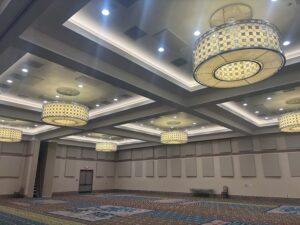Texas Assisted Living Centers Backup Power Guide
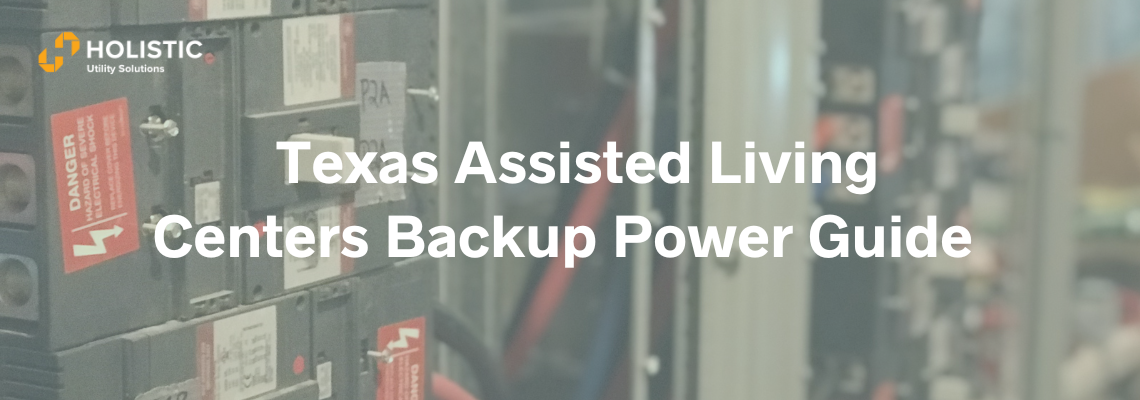
Texas Assisted Living Centers Backup Power Guide
The rise of high-profile natural disasters and large-scale power outages in recent years has raised concerns on how assisted living centers provide backup power during these events.
In this resource article we’ll discuss:
- Why Assisted Living Centers Need Backup Power
- Active or proposed legislation that may mandate backup power
- Technical solutions to backup power for short term and long term durations
- Ways to lower project cost through grants, incentives, financing, and long-term savings
What’s Driving the Need for Backup Power
Backup power, defined as an alternate source of electricity during a power outage, has become a hot topic over the past 5 years. This is primarily due to several high-profile natural disasters that led to wide scale power outages. Texas is the primary example of this issue.
While nearly all assisted living centers have small generators to power fire protection systems and small loads, not all of them have systems large enough to power heating and air systems for long periods (3-4 days).
Extreme Temperatures & Natural Disasters
In 2021, Winter Storm Uri brought unprecedented freezing temperatures, snow, and ice throughout Texas. This led to rolling blackouts throughout the state, with many critical facilities losing power for days on end. While not directly related to assisted living centers, 147 individuals 60 years or older lost their lives during Uri. This was more than half of all deaths associated with the storm and brought attention to the vulnerability of this population.
More recently, the Houston area was impacted Hurricane Beryl in 2024. During Beryl, 30 assisted living centers and 14 nursing homes lost power in Harris County alone.
Even without these large scale outages, extremely hot Summer temperatures have put strain on the grid. While ERCOT has been able to avoid outages so far, there have been several close calls when hot weather combined with fluctuating power supply have risked localized outages.
Aging Infrastructure
The second issue contributing to the need for backup power is aging infrastructure. Much of the Texas power grid is 50+ years old. As demographics and technology shifts, the load on these grids becomes more concentrated in certain areas. This leads to overloading at critical times, bringing the risk of brownouts and blackouts.
Population Growth
The last issue contributing to the need for backup power is the surge in population throughout Texas. As more people move here, the demand for power continues to increase. Solar and Wind have helped with this, but since they are intermittent loads there are still short periods when parts of the state are low on power.
Legislative Response
The issues surrounding grid reliability and its impact on vulnerable populations has led to local and state governments proposing, and in some cases adopting, mandatory requirements for assisted living centers to implement backup power adequate to maintain safe temperatures in some or all of the occupied spaces.
This is not an unprecedented move. In Florida, legislation was passed at the state level in 2018 to ensure that all assisted living centers have backup power adequate to power heating and cooling systems.
Texas State Legislation
At the time of this writing (January 2025), there are several bills proposed in the 89th Legislative Session concerning statewide assisted living backup power mandates. The current bills include House Bill 1199 (HB 1199), House Bill 1467 (HB 1467), and Senate Bill 481 (SB 481). These all have similar components, but are slightly different.
A summary is provided below. Each bill’s full text is hyperlinked to the Bill Number.
| Bill | Impacted Facilities | Technology Allowed | Minimum Area Served | Minimum Hours of Service | Deadline to Implement |
| HB 1199 | “nursing facilities and assisted living facilities” | “emergency generator or comparable emergency power source”
This can include natural gas generators. Battery is not excluded either. |
“an area in the facility of sufficient size to at all times safely maintain residents as appropriate for resident needs” | 72 Hours
(3 days) |
September 1, 2026
Extensions of 1 year may be requested. Not more than 3 total extensions. (Final deadline September 1, 2029) |
| HB 1467 | “Assisted living facility” meaning a facility
licensed under Chapter 247, Health and Safety Code |
“emergency generator or comparable emergency power source
This can include natural gas generators. Battery is not excluded either. |
“maintain functional electrical outlets to accommodate essential medical equipment of facility residents, including equipment necessary for respiratory care” in “an area in the facility of sufficient size to at all times safely maintain facility residents as appropriate for resident needs” | 72 Hours
(3 days) |
September 1, 2026
Extensions of 1 year may be requested. Not more than 3 total extensions. (Final deadline September 1, 2029) |
| SB 481 | “nursing facilities and assisted living facilities” | “an emergency generator or alternate power source” | “maintain a temperature between 71 degrees and 81 degrees Fahrenheit”
(this appears to be referring to cooling temperatures) |
96 Hours
(4 days) |
Effective September 1, 2025. Unclear on deadline for installation of equipment, as this likely refers to having a plan |
These Texas Bills are part of the 89th Legislative Session and have faced mixed response from industry associations. While the intent of the bills is noble, there are valid concerns about the cost and logistics of implementing the required measures.
SB 1368
One additional bill that was introduced by Sen. Boris Miles on February 18, 2025 is a bit broader than the three above. It is Senate Bill 1368 and full text can be viewed here.
Rather than specifying a specific type of backup power, this bill specifies that each facility have a plan and is able to provide each resident a “climate-controlled area of refuge with at least 15 square feet per resident”. In addition, any bedfast residents must have a climate controlled room.
Climate-controlled is defined as maintaining “a temperature between 68 and 82 degrees Fahrenheit”.
Note that since SB 1368 is not as prescriptive regarding type of backup power and duration, it should be easier to comply with while still meeting the intent of providing safe and reliable power for residents in the event of extended outages.
Harris County (Texas) Fire Code
Early in 2025, assisted living centers throughout the unincorporated areas of Harris County learned that an amendment to the Fire Code included provisions mandating backup power in facilities.
Note that this only impacts the Unincorporated areas of Harris County. Based on our research, this covers 100-120 assisted living centers. A map of unincorporated Harris County is included for reference.
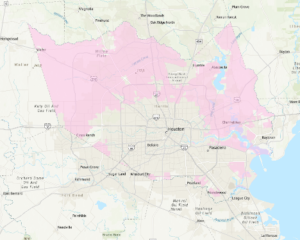
While Harris County uses the 2021 IFC, there are specific amendments added to the standard code for local provisions. Section 1203.2.21 was modified to add the following:
1203.2.21 Group I-1 and I-2. In addition to other provisions in this code, secondary power shall be provided for Group I-1 assisted living facilities and Group I-2 nursing homes to provide power for simultaneous operation of the following:
-
- Heating, ventilation, and air conditioning systems for all areas occupied by residents or patients
- Fire alarm system, if provided
- Fire pump, if provided
- Emergency exit signs
- Emergency egress illumination
- All electrically operated locks or latches on egress doors which do not fail to an unlocked position when power is lost, if provided
- All power-operated doors which cannot be in an unlocked, open position on a 24-hour basis, if provided
- Smoke control systems provided for egress safety, if provided
- Emergency responder communication coverage systems, if provided
- Refrigeration for food preservation and medication stability
- Potable water booster pumps for buildings three stories or more
- Elevators used for egress paths in buildings four stores or more above exit discharge
- Other equipment and devices required for preservation of life
The secondary power supply can be a permanent on-site emergency or standby generator, fuel cell, or a mobile power supply were approved by the fire code official. Where the secondary power source is not a permanent on-site system, the facility shall submit a plan to the fire code official detailing how secondary power will be provided. The secondary power supply plan shall become a component in the fire and life safety plan for the facility. Where the secondary power source is a mobile power supply located off-site and operated under contract to be delivered to the facility at times of need, the secondary power supply shall be capable of being delivered, connected and providing power within a 3-hour time frame following the loss of power.
Source: Page 78 of this link: Harris County Fire Code
This code currently requires that facilities comply by January 1, 2026. If not ready by this date, the site must at least have a shoreline connection point to connect in an emergency generator by Jan. 1, 2026.
We have not seen any specifics regarding allowable technology or duration of backup power as addressed in the House and Senate bills.
However, since these are part of the 2021 International Fire Code and they have referenced Group I-1 and I-2 facilities under broader “critical facilities section, we believe we can reference the requirements of NFPA 110 Level 1 systems.
If so, this would likely indicate the system must be able to run at least 96 hours under full load. This requires on-site fuel supply for this period plus resupply contracts should the outage go longer. There may also be requirements for system redundancy, such as multiple generators, to avoid single points of failure.
The above observations are preliminary assumptions and should not be considered final interpretation of the code. We expect further clarification will be issued by Harris County in 2025.
Technical Solutions
The traditional method to meet emergency and/or standby power system requirements are diesel or natural gas generators. More recently, battery storage systems have also become a possible solution for some situations, albeit still at a higher initial cost.
Diesel Generators
Diesel generators provide the benefit of being fully self-contained. During Winter Storm Uri, there were some issues with gas pressure being lost. The flip side is that diesel can also be hard to obtain during a true emergency, so systems may be limited to the on-site storage capacity.
A 150KW generator, which is likely approximately what a midsize assisted living center would require, running 96 hours would consume approximately 800 gallons. Since legislation requires 72-96 hours and assumes full load, it is safe to assume 750-1,000 gallons would need to be stored on site. Here’s a 1,000 gallon above ground, double wall storage tank for reference.
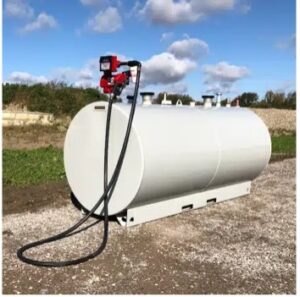
Diesel generators may also require more stringent emission controls to participate in certain operations. Since diesel produces Nitrous Oxide (NOx) and Particulate Matter (PM), regulatory agencies may require Tier 4 rating or aftermarket Diesel Oxidation Catalysts (DOCs) and SCR (Selective Catalytic Reduction).
Note this level of emission control is generally not required for emergency-use only generators (Tier 2 will suffice). Not having these emission controls does limit some of the options we will discuss later to use the generators to reduce energy cost and offset their cost.
Natural Gas Generators
In contrast to diesel generators, Natural Gas generators usually do not require the enhanced emission controls and therefore can be used for non-emergency uses. When natural gas is available, they also can run indefinitely without needing external resupply and the environmental liability of storing large amounts of diesel fuel on site.
Battery Energy Storage Systems (BESS)
As battery technology has advanced in recent years, costs have decreased and the use of battery energy storage systems (BESS) has become feasible in some applications. While BESS systems can be recharged by on-site solar PV systems, this is unlikely to meet the requirements of the pending legislation. The system would therefore need to power the building for the time needed without being recharged.
Similar to generator systems, where capacity is a combination of generator size (in KW) and fuel tank capacity, BESS systems are rated both in their maximum discharge capacity (KW) and duration (KWh).
Since legislation does not specifically mandate generators as the only allowable backup power source, battery systems should also meet the requirement of proposed legislation. Batteries hold the advantage of providing low maintenance, silent operation, and ability to use for non-emergency uses.
Below is a graph showing the energy usage of a building with a 111KW peak load during the month of August. This site was an office building and clearly uses more power during the day when air conditioning is running.

Over a 96-hour period, this site uses about 4,250kWh of power (4.25 MWh).
For perspective, the Tesla Megapack is 3.9MWh, so one of these would be close to meeting the 96-hour requirement. The system would cost approximately $1M + installation, for an estimated total of $1.5-2M. This is before potential tax incentives.
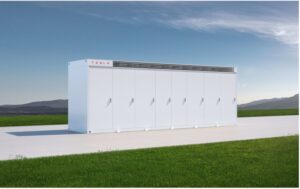
Given the cost of the systems of this size vs. a generator, we would rarely recommend them as the primary backup power.
There are, however, situations where a battery in combination with a generator could help reduce the net system cost over time.
Reducing System Cost
While the intent is altruistic, the primary concern with the proposed or active legislation is how to pay for it.
A 150KW generator project will likely cost $150k+ depending on complexity of install and exact equipment specified. For a battery system, the long duration of the system would require an initial investment of $1.5M+ for the same capacity.
Here’s some ways to help offset the cost.
Obtain Grants
There may be grants available through Federal, State, or non-profits to assist with the cost of implementing these projects.
Texas Backup Power Package Program (TBPP)
The program we are watching most closely here in Texas is the “Texas Backup Power Package Program” (TBPP).
According to the official website, “These funds enable qualified applicants to install backup power sources at facilities that support community health, safety, and well-being.”
While there isn’t much official guidance provided on the TBPP as of the time of this writing (January 2025), a review of the Advisory Committee Recommendations released October 1, 2024 can provide some good clues.
First, assisted living centers are on the top of the list of proposed facilities that would qualify for funding:
- facilities providing hospice, nursing, assisted living, end-stage renal disease treatment and dialysis;
The funding would provide grants of $500/KW. This is based on facility/critical peak load, not generator size.
The proposal includes requirements that solar and battery also be paired with the generator installation. Note these would be eligible for separate incentives and tax credits as discussed later.
Since the grant will not cover 100% of system cost, the TBPP also encourages utilizing financing strategies such as C-PACE or Resiliency-as-a-Service. We will discuss both of these later.
USDA REAP Grant
The REAP Grant can pay for 25-50% of energy efficiency and/or renewable energy projects for qualifying entities.
To qualify, the entity must be a Small Business and be located in a qualifying Rural Area.
Grant applications are submitted on a quarterly rolling basis. Level of effort on the application varies based on project size.
You can read more about this program in our resource article “Texas REAP Grant Guide“.
Leverage Ongoing Savings
A reliable way to lower the net cost of a system is using the generator to lower energy costs. This is done by proactively shifting the building on to generator during non-emergency times when energy prices are high and/or the grid is strained.
The trick with this strategy is ensuring the environmental permitting allows the generators to be used for “economic” function and not just “emergency” function.
Recall we discussed how diesel generators have a Tier rating system. Tier 4 diesel generators have adequate emission controls that typically allow them to be used for economic load shedding.
Similarly, natural gas generators are typically able to participate in these strategies.
Because of this, the net cost (after savings) of installing and properly utilizing a Tier 4 or Natural Gas generator may be less than a Tier 2 generator that can only be used for emergency use.
The savings from the programs vary based on your facilities load profile, size, etc.
Take A Holistic Approach
Even if a generator is only eligible for emergency use and cannot reduce energy cost by itself, combining with other energy saving measures can still reduce net project cost.
The best examples of these are Energy Efficiency and Solar and/or Battery.
Energy Efficiency
Investing in energy efficiency will reduce the consumption of electric and gas. The most common examples of these include:
- LED Lighting Retrofits
- Building Automation (Thermostats, lighting sensors, etc.)
- HVAC Replacement or Re-commissioning
- Weatherization (insulation, weatherstripping, etc.)
- Smart Irrigation (water savings)
Since many of these measures are eligible for additional grants and incentives, they often pay for themselves in 1-5 years.
By bundling these with the generator project, the savings from energy efficiency can help offset the cost of the generator.
Solar and/or Battery
Solar and Battery have become more common and cost effective in recent years due to:
- rising electric cost
- lower solar system cost
- increased incentives.
When combined with utility rebates, tax incentives, and other grants a solar and/or battery system can often pay for itself in 4-10 years. Leveraging these savings can help offset the generator cost.
Financing Systems
Once the full scope of the project is determined, the optimal financing method can be determined. Since conventional commercial loans or cash is a given, we’ll focus on two alternate strategies specific to generators and/or projects combined with solar/energy efficiency.
“Green” Loans
This method is unlikely to fund generator only projects, but is a potential option if the project is combined with energy and/or solar improvements.
PACE Financing
Perhaps the most common fund is Property Assessed Clean Energy (PACE) funding. These loans are designed to allow commercial buildings to finance energy improvements over long periods (20-30 years) so that the savings from the project offset the principal and interest payments.
PACE is offered in many states when it is sponsored by a local taxing authority (City of County). More information on Texas programs can be found here.
SBA 504 Green Loan
If your entity qualifies as a small business, it may be eligible for a special SBA504 loan that provides favorable rates and terms with the requirement that the facility reduce energy consumption and/or offset energy use with renewable power.
These loans can be up to $5.5M and require a 15% reduction in energy consumption or 15% offset from solar.
Lease/As-a-Service Agreements
Solar projects have long used a Power Purchase Agreement (PPA) contract to finance installation of systems. In more recent years, this strategy has been adapted to energy efficiency and generator installation programs as well. This is often called “Energy-as-a-Service” or “Resilience-as-a-Service”.
In summary, a 3rd party installs, owns, and operates the improvements at your facility. In exchange, you sign a contract to pay over some term (typically 10-20 years). At the end of the term, there is a predetermined buy-out option so you can take ownership of the assets.
Payments on these programs can be structured in different ways. Sometimes they are based on the energy saved or produced. Other times they are a fixed payment, similar to an equipment lease.
Since the installed measures provide ongoing savings, the lease cost is partially or fully offset. This may reduce cost to a lower payment than traditional financing on an emergency use only generator.
The benefit to you is little to no out of pocket cost, less debt on the books, and less responsibility for operations and maintenance. It is the “easy button”.
The only downside is cost may be slightly higher than one of the financed options (PACE, SB504, etc.) due to risk premium, cost of capital, etc.
Putting it All Together
We’ve covered a lot of information that may be overwhelming to digest, so let’s put together an example.
Suppose you need to comply with the mandates and install a 150KW generator for a cost of $125k.
If you finance on a convention loan with a 10-year term at 8% interest, your annual cost would be approximately $18k.
Now instead suppose you choose to go with a Tier 4 or Natural Gas generator at $150k and bundle in another $350k of energy efficiency and/or solar work that will receive $100k one time incentive and save $20k/yr on energy cost. In addition, upgrading the generator brings in another $10k in savings.
This combined projects makes you eligible for a PACE or SBA loan that allows a 20-year term at 6.5% interest. We are now financing $400k (project cost net of one-time incentives) for a payment of $36k/yr.
However, remember that this project yields $30k in ongoing savings, making the net cost only $6k per year instead of $18k.
If you chose to use a lease structure or Energy-as-a-Service (EaaS), the net payment would likely be somewhere between the $6k on the financed approach and $18k for a generator only. This difference is the profit and management cost for the 3rd party to finance and manage the project.
Next Steps
Whether you’re one of the 100+ assisted living centers trying to figure to pay for the Harris County backup power mandate or one of the hundreds more throughout Texas planning for future disasters or potential statewide mandates, we hope the strategies discussed here are helpful.
We at Holistic Utility Solutions specialize in helping owners and operators like you put together these strategies to minimize your cost while improving your resident health and safety.
We are based in North Texas and offer turnkey guidance from site assessments, project development, financing support, and construction oversight for holistic utility solutions.
Let’s connect if you think we might help you.

